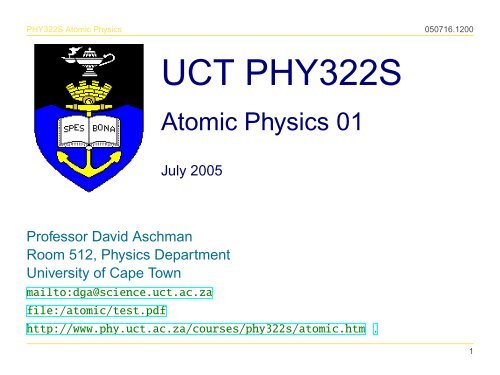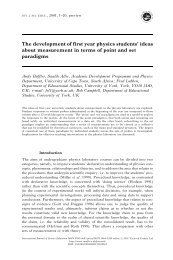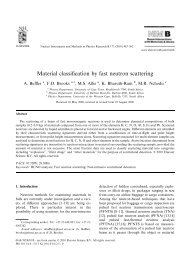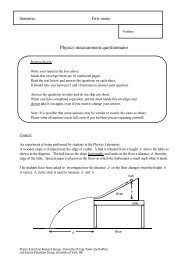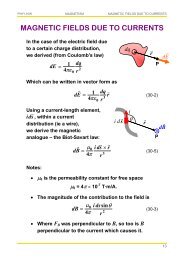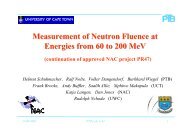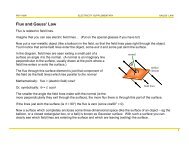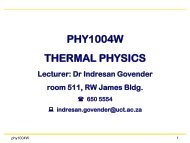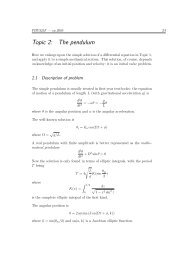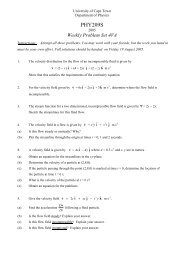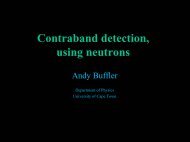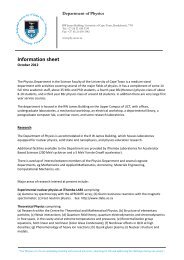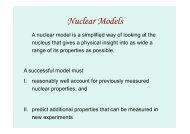Atomic01 - University of Cape Town
Atomic01 - University of Cape Town
Atomic01 - University of Cape Town
Create successful ePaper yourself
Turn your PDF publications into a flip-book with our unique Google optimized e-Paper software.
PHY322S Atomic Physics 050716.1200<br />
UCT PHY322S<br />
Atomic Physics 01<br />
July 2005<br />
Pr<strong>of</strong>essor David Aschman<br />
Room 512, Physics Department<br />
<strong>University</strong> <strong>of</strong> <strong>Cape</strong> <strong>Town</strong><br />
mailto:dga@science.uct.ac.za<br />
file:/atomic/test.pdf<br />
http://www.phy.uct.ac.za/courses/phy322s/atomic.htm .<br />
1
PHY322S Atomic Physics .<br />
Philosophy <strong>of</strong> lecturing and teaching<br />
Pre-lecture reading assigned (see website)<br />
Concepts and problems to think about and discuss<br />
Questions in class<br />
Lecture<br />
Reading<br />
discussion with class tutor and lecturer<br />
Problem sets: attempt them early in the week<br />
2
PHY322S Atomic Physics .<br />
Atomic Physics: Websites<br />
http://www.phy.uct.ac.za/courses/phy322s/<br />
Others: see PHY322S website, or Google<br />
3
PHY322S Atomic Physics .<br />
Quantum Mechanics: Textbooks<br />
Cassels JM, Basic Quantum Mechanics (Macmillan)<br />
Griffiths D, Intro to Quantum Mechanics (Prentice Hall)<br />
Rae A, Quantum Mechanics (IoP)<br />
Feynman R, Lectures on Physics Vol3 (Addison Wesley)<br />
Greiner W, Quantum Mechanics (Springer Verlag)<br />
Bransden B & Joachain C, Intro to Quantum Mechanics (Longmans)<br />
Eisberg R & Resnick R, Quantum Physics <strong>of</strong> Atoms . . . (Wiley)<br />
Brehm and Mullin, Introduction to the Structure <strong>of</strong> Matter (Wiley)<br />
4
PHY322S Atomic Physics .<br />
Atomic Physics: Textbooks<br />
Foot C, Atomic Physics (Oxford)<br />
Haken H & Wolf H, Physics <strong>of</strong> Atoms and Quanta (Springer)<br />
Branden B & Joachain C, Physics <strong>of</strong> Atoms and Molecules (Longmans)<br />
Woodgate G, Elementary Atomic Structure (Oxford)<br />
5
PHY322S Atomic Physics<br />
Atoms<br />
link http://www.sljus.lu.se/stm/NonTech.html<br />
Silicon atoms on<br />
surface seen by<br />
atomic force<br />
microscope<br />
(Lund)<br />
6
PHY322S Atomic Physics .<br />
Atomism<br />
Greeks - four elements: earth water air fire.<br />
A’tom: uncuttable. Lucretius, . . . , Dalton<br />
Spectral lines - Balmer, . . .<br />
Thomson - electron<br />
Radioactivity - Bequerel, Rutherford<br />
Atom → electrons and nucleus (Bohr, Rutherford)<br />
Quantum structure: Balmer, Bohr, Rutherford, Heisenberg, Schrodinger,<br />
Pauli, Dirac<br />
7
PHY322S Atomic Physics .<br />
Nucleus - protons and neutrons. Bohr, Wheeler, Wigner<br />
. . . Complicated force. Liquid drop model. Nuclear shell model.<br />
Deformation, . . . A rich mesoscopic quantum fluid. The strong<br />
internucleon force - potential or QCD?<br />
Proton, neutron → quark model<br />
Quarks → (super)strings? → ??<br />
Leptons: electron, muon, neutrinos . . .<br />
Radiation: photons, . . . [gauge bosons]<br />
Dark matter. Dark energy. [Quintessence ??]<br />
8
PHY322S Atomic Physics .<br />
Problems with atom as classical object<br />
All hydrogen atoms alike: r = a 0 ∼ 0.53 × 10 −10 m.<br />
Classical atom (Coulomb force provides centripetal force):<br />
mv 2 /r = (1/4πɛ 0 )e 2 /r 2<br />
Problems:<br />
1) Atom could be any size: If r(t) is solution; scale by k and k 2 r(t/k 3 ) is<br />
ALSO a solution. Who sets k?<br />
2) Atom is unstable. Accelerate charge radiates, so spirals in. Lifetime<br />
∼ 10 −11 s<br />
/...<br />
9
PHY322S Atomic Physics .<br />
Atom as a quantum object<br />
Atom is a QUANTUM object. Enter . Bohr quantizes angular<br />
momentum mva 0 = giving<br />
a 0 = 2<br />
me 2 = 0.53 × 10−10 m<br />
Energy is −13.6 eV. Binding energy. Is atom big or small? How strong<br />
is electromagnetic interaction? Is motion non-relativistic? We must<br />
interpret a 0 .<br />
10
PHY322S Atomic Physics .<br />
Atomic size from uncertainty principle<br />
Assume electron confined to atomic box <strong>of</strong> size a. Uncertainty principle<br />
says momentum p ∼ /a, so non-relativistic kinetic energy is p 2 /2m.<br />
Add Coulomb energy to get total<br />
E ∼<br />
2<br />
2ma − e 2<br />
2 (4πɛ 0 )a<br />
Choose a to get a 0 that minimizes E, ie set dE/da = 0<br />
a 0 = 4πɛ 0 2<br />
e 2 m<br />
( = 4πɛ0 c<br />
)( <br />
)<br />
e 2 mc<br />
= α −1 λ e<br />
where fine structure constant α = (1/4πɛ 0 )(e 2 /c) ∼ 1/137<br />
and electron Compton wavelength λ e = /mc ∼ 3.85 × 10 −13 m<br />
Atomic size a 0 = (137)(3.85 × 10 −13 ) ≃ 0.53 × 10 −10 m.<br />
11
PHY322S Atomic Physics .<br />
Physical quantities with m, , c<br />
For a particle <strong>of</strong> mass m, we can use physical constants and c, to<br />
form dimensionally correct quantities<br />
m = [mass]<br />
mc = [momentum]<br />
mc 2 = [energy]<br />
mc 2 / = [time] −1<br />
/mc 2 = [time]<br />
/mc = [length]<br />
12
PHY322S Atomic Physics .<br />
Natural units: the factor c<br />
To evaluate an expression in natural units where [ = c = 1], put in<br />
factors and c to get known groupings, eg mc 2 , then finally replace c<br />
factors with<br />
c = (2π) −1 (6.6 × 10 −34 )(1.6 × 10 −19 ) −1 (3 × 10 8 )(10 9 ) eV nm<br />
= 197 eV nm<br />
= 197 MeV fm<br />
13
PHY322S Atomic Physics .<br />
Tentative outline <strong>of</strong> the course<br />
Early quantum ideas<br />
Blackbody radiation and Planck. Photoelectric effect. Einstein equation. de Broglie<br />
relation, electron diffraction. Compton scattering.<br />
Steps towards wave mechanics<br />
Wave-particle duality, Uncertainty principle. Schrödinger equation (time dependent,<br />
independent). Intepretation <strong>of</strong> wavefunction.<br />
One-dimensional time-independent problems<br />
Square well potential (infinite, finite). Probability flux. Potential barrier and step.<br />
Reflection and transmission. Tunnelling. Wavepackets. Simple harmonic oscillator.<br />
14
PHY322S Atomic Physics .<br />
The formal basis <strong>of</strong> quantum mechanics<br />
Postulates <strong>of</strong> quantum mechanics operators, observables, eigenvalues, eigenfunctions.<br />
Hermitian operators and the Expansion Postulate.<br />
Angular momentum in quantum mechanics<br />
Operators, eigenvalues and eigenfunctions <strong>of</strong> ˆl 2 and ˆl z .<br />
The hydrogen atom<br />
Separation <strong>of</strong> space and time parts <strong>of</strong> the 3D Schrödinger equation for a central field.<br />
Radial wave equation and series method solution. Degeneracy and spectroscopic<br />
notation.<br />
/. . .<br />
15
PHY322S Atomic Physics .<br />
Electron spin and total angular momentum<br />
Magnetic moment <strong>of</strong> electron due to orbital motion. The Stern-Gerlach experiment.<br />
Electron spin and complete set <strong>of</strong> quantum numbers for the hydrogen atom. Addition<br />
<strong>of</strong> angular momentum quantum numbers. Total spin and orbital angular momentum<br />
quantum numbers S , L, J.<br />
Emission and absorption <strong>of</strong> radiation by atoms<br />
Interaction <strong>of</strong> atoms with an EM field. Selection rules for radiative transitions in<br />
hydrogen and complex atoms.<br />
16
PHY322S Atomic Physics .<br />
Blackbody radiation & ultraviolet catastrophe<br />
(a) Spectrum <strong>of</strong> blackbody radiation & Rayleigh-Jeans law<br />
(b) Spectrum as a function <strong>of</strong> temperature<br />
17
PHY322S Atomic Physics .<br />
Wave particle duality<br />
Evidence for wave-particle duality:<br />
Photoelectric effect<br />
Compton effect<br />
Electron diffraction<br />
Interference <strong>of</strong> matter-waves<br />
Consequence:<br />
Heisenberg uncertainty principle<br />
18
PHY322S Atomic Physics .<br />
Photoelectric effect<br />
UV light shining on metal plate in a vacuum, causes emission <strong>of</strong><br />
charged particles (Hertz 1887); later shown to be electrons by J.J.<br />
Thomson (1899).<br />
Hertz J.J. Thomson<br />
Classical expectations: Electric field E <strong>of</strong> light exerts force F = −eE<br />
on electrons. As intensity <strong>of</strong> light increases, force increases, so KE<br />
<strong>of</strong> ejected electrons should increase. Electrons should be emitted<br />
whatever the frequency <strong>of</strong> the light, so long as E is sufficiently large.<br />
For very low intensities, expect a time lag between light exposure<br />
and emission, while electrons absorb enough energy to escape from<br />
material.<br />
19
PHY322S Atomic Physics .<br />
Photoelectric effect: Einstein’s hypothesis<br />
Experiment: Maximum KE <strong>of</strong> ejected electrons is independent <strong>of</strong><br />
intensity, but dependent on ν. For ν < ν 0 i.e. for frequencies below<br />
a cut-<strong>of</strong>f frequency) no electrons are emitted. There is no time lag.<br />
However, rate <strong>of</strong> ejection <strong>of</strong> electrons depends on light intensity.<br />
Einstein interpretation (1905): Light comes in packets <strong>of</strong> energy<br />
(photons) E = hν, An electron absorbs a single photon to leave the<br />
material<br />
The maximum kinetic energy <strong>of</strong> an emitted electron is E k = hν − W<br />
Planck constant h = 6.63 × 10 −34 Js. Work function W ∼ 3 eV.<br />
Verified in detail through subsequent experiments by Millikan.<br />
20
PHY322S Atomic Physics .<br />
Relation between particle and wave properties <strong>of</strong> light<br />
Energy and frequency E = hν<br />
Relativistic formula relating energy and momentum E 2 = (pc) 2 + (mc 2 ) 2<br />
Momentum related to wavelength p = h/λ<br />
For light: E = pc and c = λν and p = h/λ = hν/c<br />
Common: = h/2π E = ω ω = 2πν k = 2π/λ<br />
21
PHY322S Atomic Physics .<br />
Compton scattering<br />
Compton, Phys. Rev. 22,409 (1923) scattered X-rays from solid target;<br />
intensity as function <strong>of</strong> wavelength for different angles. (1927 Nobel).<br />
Shift to longer wavelength <strong>of</strong> peak in scattered radiation depends on θ<br />
(but not on the target material).<br />
22
PHY322S Atomic Physics .<br />
Compton scattering<br />
Classically, expect no change in frequency <strong>of</strong> radiation.<br />
Comptons explanation: billiard ball collisions between particles <strong>of</strong> light<br />
(X-ray photons) and electrons in the material<br />
Conservation <strong>of</strong> energy: hν + m e c 2 = hν ′ + (p 2 ec 2 + m 2 ec 4 ) 1/2<br />
Conservation <strong>of</strong> momentum: p = (h/λ)î = p ν ′ + p e<br />
23
PHY322S Atomic Physics .<br />
whence . . .<br />
λ ′ − λ =<br />
h (1 − cos θ)<br />
m e c<br />
Compton wavelength <strong>of</strong> the electron λ c = (h/(m e c)) = 2.4 × 10 −12 m<br />
At all angles an unshifted peak arises from collisions between X-ray<br />
photon and the nucleus <strong>of</strong> the atom<br />
λ ′ − λ =<br />
h (1 − cos θ) ∼ 0<br />
m N c<br />
since m N ≫ m e<br />
24
PHY322S Atomic Physics .<br />
Wave particle duality<br />
There are therefore now two theories <strong>of</strong> light, both indispensable, and<br />
without any logical connection. - Einstein (1924)<br />
Evidence for wave-nature <strong>of</strong> light: Diffraction and interference<br />
Evidence for particle-nature <strong>of</strong> light:<br />
effect<br />
Photoelectric effect, Compton<br />
25
PHY322S Atomic Physics .<br />
Matter waves<br />
We have seen that light comes in discrete units (photons) with particle<br />
properties (energy and momentum) that are related to the wave-like<br />
properties <strong>of</strong> frequency and wavelength.<br />
In 1923 Prince Louis de Broglie postulated that ordinary matter can<br />
have wave-like properties, with the wavelength related to momentum<br />
in the same way as for light<br />
λ = h p<br />
Prediction: we should see diffraction and interference <strong>of</strong> matter waves.<br />
de Broglie wavelength depends on momentum, not on the physical size<br />
<strong>of</strong> the particle<br />
26
PHY322S Atomic Physics .<br />
Estimation <strong>of</strong> some de Broglie wavelengths<br />
Wavelength <strong>of</strong> electron with 50 eV kinetic energy<br />
K = p2<br />
2m e<br />
=<br />
h2<br />
2m e λ 2 → λ =<br />
h<br />
√ 2me K = 1.7 × 10−10 m<br />
Wavelength <strong>of</strong> nitrogen molecule at room temperature<br />
K = (3/2)kT, M = 28m u λ = h/ √ 3MkT = 2.8 × 10 −11 m<br />
Wavelength <strong>of</strong> rubidium-87 atom at 50nK<br />
λ = h/ √ 3MkT = 1.6 × 10 −6 m<br />
27
PHY322S Atomic Physics .<br />
Electron diffraction: Davisson-Germer experiment<br />
Davisson-Germer (1927) scatter beam <strong>of</strong> electrons from a Ni crystal.<br />
[Davison, ”Are Electrons Waves?,” Franklin Inst. J. 205, 597 (1928)]<br />
At fixed accelerating voltage a pattern <strong>of</strong> sharp reflected beams from<br />
the crystal. At fixed angle, find sharp peaks in intensity as a function<br />
<strong>of</strong> electron energy (1937 Nobel). GP Thomson performed similar<br />
interference experiments with thin-film samples.<br />
28
PHY322S Atomic Physics .<br />
Electron diffraction (cont.)<br />
Interpretation: similar to Bragg<br />
scattering <strong>of</strong> X-rays from crystals.<br />
Path difference: Constructive<br />
interference path difference a whole<br />
number <strong>of</strong> wavelengths<br />
a(cos θ r − cos θ i ) = nλ<br />
Note difference from usual Bragg<br />
Law geometry: scattering planes<br />
are oriented perpendicular to<br />
surface.<br />
Note θ i not necessarily equal to θ r .<br />
Electron scattering dominated by<br />
surface layers.<br />
29
PHY322S Atomic Physics .<br />
Young’s double slit experiment<br />
Young (1801) demonstrates the wave-nature <strong>of</strong> light. Has now been<br />
done with electrons, neutrons, He atoms . . . . Expect two peaks for<br />
particles, interference pattern for waves.<br />
30
PHY322S Atomic Physics .<br />
Double Slit - experiments<br />
Interference patterns can not be explained classically. Clear<br />
demonstration <strong>of</strong> matter wave hypothesis.<br />
31
PHY322S Atomic Physics<br />
Double slit experiment with helium atoms<br />
Carnal & Mlynek, Phys. Rev. Lett.,66,(1991) p2689<br />
Carnal & Mlynek, Phys. Rev. Lett., 66, (1991) p2689.<br />
Experiment: He atoms at 83 K, with d = 8 µm and D = 64 cm.<br />
Path difference d sin θ. Constructive interference: d sin θ = nλ.<br />
Expected separation between maxima: ∆y = λD/d<br />
Measured separation: ∆y = 8.2 µm<br />
Energy K = 3kT/2, M = 4m u<br />
Predicted de Broglie wavelength: λ = h/ √ 3MkT = 1.03 × 10 −10 m<br />
Predicted separation: ∆y = 8.4 ± 0.8 µm<br />
Good agreement with experiment.<br />
32
PHY322S Atomic Physics .<br />
Fringe spacing in double slit experiment<br />
Maxima when d sin θ = nλ<br />
D ≫ d so use small angle<br />
approximation<br />
θ ≃ nλ/d<br />
so ∆θ ≃ λ/d<br />
Position on screen: y = D tan θ ≃<br />
Dθ<br />
Separation between adjacent<br />
maxima:<br />
∆y ≃ D∆θ<br />
∆y ≃ λD/d<br />
33
PHY322S Atomic Physics<br />
Double Slit experiment: interpretation<br />
Feynman Lectures Vol 3 Ch2<br />
Interference pattern persists at low intensity, even with one atom<br />
arriving at a time:<br />
Particle goes through both slits.<br />
Wave behaviour shown by a single atom:<br />
matter-wave inteferes with itself.<br />
If we try to detect which slit particle went though, interference pattern<br />
vanishes:<br />
we cannot see particle and wave nature at the same time.<br />
The importance <strong>of</strong> the two-slit experiment has been memorably<br />
summarized by Richard Feynman: . . . phenomenon which is<br />
impossible, absolutely impossible, to explain in any classical way, and<br />
which has in it the heart <strong>of</strong> quantum mechanics. In reality it contains<br />
the only mystery.<br />
34
PHY322S Atomic Physics .<br />
Double slit experiment - bibliography<br />
See Physics World(September 2002) article http://physicsweb.<br />
org where the double-slit experiment was voted the most beautiful<br />
experiment in physics.<br />
35
PHY322S Atomic Physics .<br />
Heisenberg γ-ray microscope<br />
The microscope is an imaginary device to measure the position y and<br />
momentum p <strong>of</strong> a particle. Resolving power <strong>of</strong> lens: ∆y ≥ λ/θ<br />
36
PHY322S Atomic Physics .<br />
Heisenberg microscope (cont.)<br />
Photons transfer momentum to the particle from which they scatter.<br />
Magnitude <strong>of</strong> p is same before and after collision.<br />
Uncertainty <strong>of</strong> photon y-momentum equal to uncertainty in particle y-<br />
momentum<br />
−p sin(θ/2) ≤ p y ≤ p sin(θ/2)<br />
Small angle approximation: ∆p y = 2p sin(θ/2) ≃ pθ<br />
de Brogile gives p = h/λ so ∆p y ≃ hθ/λ<br />
and ∆y ≥ λ/θ hence<br />
∆p y ∆y ≃ h<br />
This is the Heisenberg uncertainty principle.<br />
37
PHY322S Atomic Physics .<br />
Measurement and uncertainty<br />
The thought experiment seems to imply that, while prior to experiment<br />
we have well defined values, it is the act <strong>of</strong> measurement which<br />
introduces the uncertainty by disturbing the particles position and<br />
momentum.<br />
It is widely accepted now that quantum uncertainty (lack <strong>of</strong><br />
determinism) is intrinsic to the theory.<br />
38
PHY322S Atomic Physics .<br />
Heisenberg uncertainty principle<br />
Formally it is shown that<br />
∆x∆p x ≥ /2∆y∆p y ≥ /2∆z∆p z ≥ /2<br />
We cannot have simultaneous knowledge <strong>of</strong> conjugate variables such<br />
as position and momenta.<br />
Note, however, ∆x∆p y ≥ 0, so arbitary precision is possible in principle<br />
for position in one direction and momentum in another etc.<br />
39
PHY322S Atomic Physics .<br />
Heisenberg uncertainty principle<br />
There is also an energy-time uncertainty relation<br />
∆E∆t ≥ /2<br />
Transitions between energy levels <strong>of</strong> atoms are not perfectly sharp<br />
in frequency. An atomic lifetime is typically τ ∼ 10 − 8 s. There is a<br />
corresponding spread in the emitted photon energy or frequency.<br />
40
PHY322S Atomic Physics .<br />
Conclusions<br />
Light and matter exhibit wave-particle duality.<br />
Relation between wave and particle properties given by the de Broglie<br />
relations<br />
E = hν p = h/λ<br />
Evidence for particle properties <strong>of</strong> light:<br />
Photoelectric effect, Compton scattering<br />
Evidence for wave properties <strong>of</strong> matter:<br />
Electron diffraction; interference <strong>of</strong> matter waves<br />
Heisenberg uncertainty principle limits simultaneous knowledge <strong>of</strong><br />
conjugate variables<br />
∆x∆p x ≥ /2∆y∆p y ≥ /2∆z∆p z ≥ /2<br />
41


